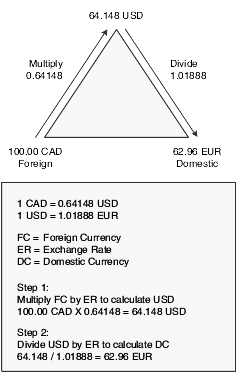Understanding the Triangulation Method
This method multiplies or divides the foreign amount by an exchange rate between the foreign and triangulation currencies to derive a calculated amount, then divides or multiplies the calculated amount by an exchange rate between the triangulation and domestic currencies to calculate the domestic amount.
To convert amounts through a triangulation currency:
Set up from and to currency relationships with a triangulation currency.
Specify a conversion method for leg 1 of the currency relationship.
If you specify the multiplier or divisor method, the system uses the reverse method for leg 2.
Enter an exchange rate for leg 1 of the currency relationship.
The triangulation method of exchange rate calculation converts amounts from one currency to another through a third currency, which is referred to as the triangulation currency. If you use the triangulation calculation method, you must also use the no inverse method. You cannot use triangulation in combination with the inverse method.
Triangulation is a composite of two exchange rates that are multiplied and divided through a third currency to produce a domestic amount. The first exchange rate is the foreign to triangulation rate and the second rate is the triangulation to domestic rate. While some companies might prefer to set up currency cross-rate relationships to produce similar results, others choose to set up triangulation.
To calculate amounts through a triangulation currency, you specify whether to use the multiplier or divisor method to convert amounts from the foreign to the triangulation currency (leg 1). The system automatically uses the opposite method to convert amounts from the triangulation to the domestic currency (leg 2). You enter an exchange rate for the foreign to domestic currency relationship and assign a triangulation currency to the record. The system automatically creates a corresponding record in the opposite direction. For example, if you enter an exchange rate from CAD to EUR with USD as the triangulation currency, the system automatically creates a record for EUR to CAD with USD as the triangulation currency.
Because triangulation is a composite of two rates that have been multiplied and divided to produce a domestic amount, two rates are retrieved and used in the calculation. Storing both rates on the transaction record is impossible. Therefore, an exchange rate of zero is stored but not used.
If you choose to set up triangulation for some currency relationships, you do not have to set it up for all currency relationships. You control whether a currency relationship uses the triangulation calculation method, just as you control whether a currency relationship uses the inverse or no inverse calculation method.
This illustration is a visual representation of triangulation:
